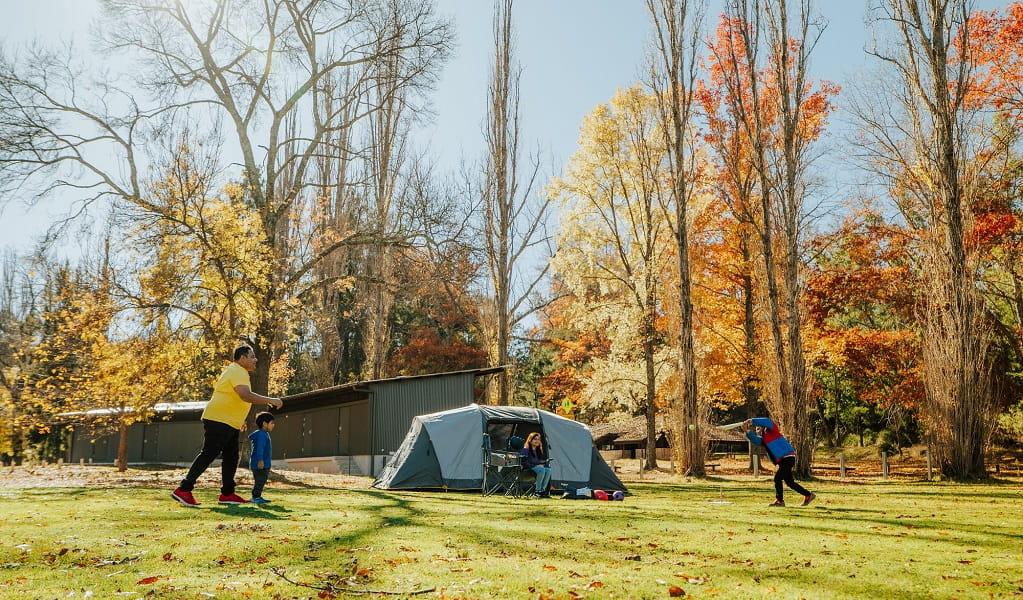Wombeyan Caves campground
Wombeyan Karst Conservation Reserve
Overview
Love the idea of sleeping in the great outdoors, but with the convenience of excellent facilities at your fingertips? That’s exactly what you’ll find at Wombeyan Caves campground.
| Camping type | Tent, Camper trailer site, Caravan site, Camping beside my vehicle |
|---|---|
| Where | 24 Wombeyan Caves Road, Wombeyan Caves, NSW, 2580 - in Wombeyan Karst Conservation Reserve |
| Facilities | Amenities block, picnic tables, barbecue facilities, drinking water, public phone, showers, toilets, electric power, washing machine |
| What to bring | Firewood |
| Group bookings | Bookings for up to 5 sites and 20 people can be made online. School groups and commercial tour operators can submit a group booking enquiry form. |
| Please note |
|
This large campground is ideal for caravans and motor homes. It also offers easy access for people using wheelchairs. Located near the reserve’s most popular attractions, it’s a great base for discovering the natural wonders of the Wombeyan area. Explore the caves on a guided tour or set out on a bushwalk from your campsite.
After a day of adventure, return to camp to enjoy a hot shower, cook a meal in the communal kitchen and toast marshmallows under the stars. You can’t collect firewood in the reserve, so remember to bring your own if you plan to light a campfire.
Also see
-

Wombeyan Caves cabins
Explore the spectacular caves at Wombeyan Karst Conservation Reserve and stay in one of these self-contained cabins. It’s a great spot for a weekend break for families and couples.
-

Kui Kiosk
Head to Kui Kiosk to learn about the experiences on offer at Wombeyan Karst Conservation Reserve.
-

Fig Tree Cave
Be sure to take a family-friendly, self-guided tour through the impressive Fig Tree Cave while you’re at Wombeyan Karst Conservation Reserve. It’s widely regarded as one of NSW’s best self-guided cave experiences.
Map legend

Map
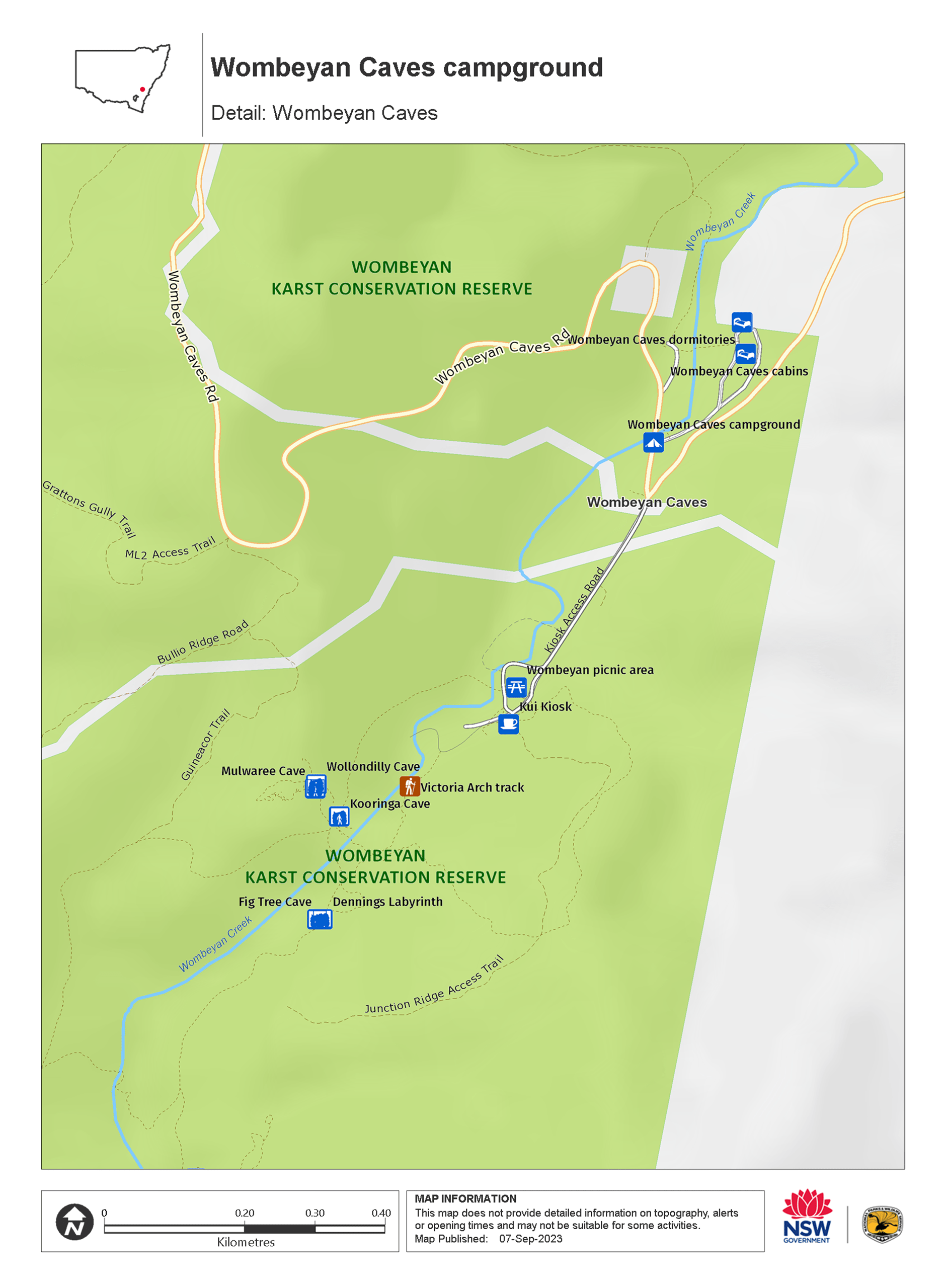
Local alerts
For the latest updates on fires, closures and other alerts in this area, see https://www.nationalparks.nsw.gov.au/camping-and-accommodation/campgrounds/wombeyan-caves-campground/local-alerts
Bookings
- National Parks Contact Centre
- 7am to 7pm daily
- 1300 072 757 (13000 PARKS) for the cost of a local call within Australia excluding mobiles
- parks.info@environment.nsw.gov.au
Park info
- in Wombeyan Karst Conservation Reserve in the Country NSW region
Wombeyan Karst Conservation Reserve is always open but may have to close at times due to poor weather or fire danger.
Visitor info
All the practical information you need to know about Wombeyan Caves campground.
Getting there and parking
You can only access Wombeyan Karst Conservation Reserve via Taralga and Wombeyan Caves Road. To get there:
From Sydney via Goulburn (3hr drive):
- Take the South Western Motorway to Goulburn
- From Goulburn, follow Tablelands Way through Taralga
- Take the Wombeyan Caves Road turnoff and drive for 23km (sealed and unsealed road).
From Sydney via Oberon (4hr drive):
- Take the M4 and Great Western Highway towards Lithgow
- Turn left onto Jenolan Caves Road, then after 23km turn right onto Duckmaloi Road
- From Oberon, follow Tablelands Way
- Take the Wombeyan Caves Road turnoff and drive for 23km (sealed and unsealed road).
From Canberra (2.5hr drive):
- Take the Federal Highway to Goulburn, then take Goulburn-Taralga-Oberon Road towards Taralga for about 45km
- Continue through Taralga for 10km until you reach the Wombeyan Caves turnoff
- Turn right onto Wombeyan Caves Road and drive for 23km (sealed and unsealed road).
From Wollongong (3hr drive):
- Take the Princes Highway towards Sydney
- Turn off at the Picton Road exit and follow for around 27km, then take the Hume Highway towards Goulburn
- From Goulburn, follow Tablelands Way through Taralga
- Take the Wombeyan Caves Road turnoff and drive for 23km (sealed and unsealed road).
Wombeyan Caves Road access via Mittagong is closed until further notice.
Refuel your vehicle on the way, as there is no petrol station at Wombeyan Karst Conservation Reserve.
Road quality
- Mixture of sealed and unsealed roads
Vehicle access
- 2WD vehicles
Weather restrictions
- All weather
Parking
The campground has 49 marked and 12 unmarked campsites. Please park as close as possible to your booked campsite to enable space for other users.
There is limited additional parking. Vehicles may park along the roadside in the general camping area.
Best times to visit
There are lots of great things waiting for you in Wombeyan Karst Conservation Reserve. Here are some of the highlights.
Autumn
Visit now and you'll see the gorgeous changing colours of the trees. The warm days and cool nights make this an ideaI time for camping.
Spring
While the caves can be visited all year round, a trip to Wombeyan in spring is well timed to catch wildflowers in full bloom.
Summer
A great time for a weekend camping trip - pitch your tent, enjoy breakfast cooked on the barbecue and the coolness of the caves on a guided tour.
Winter
Take advantage of the cooler weather and book a weekend getaway at Wombeyan Caves cabins.
Weather, temperature and rainfall
Summer temperature
Average
13°C and 26°C
Highest recorded
38.8°C
Winter temperature
Average
1°C and 11°C
Lowest recorded
-9.6°C
Rainfall
Wettest month
June
Driest month
April
The area’s highest recorded rainfall in one day
174.2mm
Facilities
- Campsites are mostly marked and suitable for motorhomes, caravans, camper trailers, campervans and tents.
- There are 17 marked powered campsites.
- In the unmarked general camping area, there are shared fire-rings.
- There is a communal kitchen and dining hall in the Barmah building.
- The kitchen has electric barbecues, electric stove/oven ($2 coin operated), microwave oven, fridge/freezer, electric kettles, washing up area and food preparation benches.
- All facilities are shared, and food items left in the fridge should be labelled.
- The dining area is located next to the kitchen and has tables, chairs and an open fireplace.
- Please ensure you leave the shared campground facilities clean and tidy with all kitchen items washed up and put away. Additional fees may be charged for any unreasonable cleaning required or missing/broken items.
- Please take your rubbish and recyclables home with you.
Amenities
There is an amenities block with hot showers and flush toilets.
Toilets
- Flush toilets
Picnic tables
Barbecue facilities
Undercover electric barbecues (free) are located opposite the cabins.
- Gas/electric barbecues (free)
- Fire rings (bring your own firewood)
Drinking water
Drinking water is available throughout the campground and camp kitchen
Public phone
There is a public phone available next to the onsite office. The phone accepts both coins and phone cards.
Showers
- Hot showers
Electric power
- Mains power is supplied to marked powered campsites as well as all campground amenities
- There are 17 powered sites in the campground.
Washing machine
There is a basic laundry with coin-operated washing machine, dryer and a laundry tub in the Barmah building.
Step-free access
The campground is mostly flat with step-free access to the kitchen and amenities block. There are no pathways in the camping area. You’ll need to cross over grass to reach the amenities block and the concrete path to the kitchen and dining area.
Maps and downloads
Accessibility
Disability access level - medium
- Assistance may be required to access this area.
- The campground is flat and there is an accessible path to the kitchen and dining area.
- A wheelchair accessible toilet and shower room is located in the amenities block.
Permitted
Generators
Please be considerate of your fellow campers if you're operating a generator. Please note that use is limited to between 8am to 10pm.
Prohibited
- Amplified music is permitted, however please consider your fellow campers.
- Noise limits apply from 10pm. Park management reserves the right to insist that offensive or excessively loud music is turned off at any time if it is causing distress to other visitors.
- Chemical toilets (for example porta potties) are not permitted.
- You can only enter caves if you have a valid ticket or token and cave entry is not allowed outside normal business hours, 9am to 3.30pm. Entry to all wild caves (unmodified) is strictly prohibited unless you have an approved permit.
Drones
Flying a drone for recreational purposes is prohibited in this area. Drones may affect public enjoyment, safety and privacy, interfere with park operations, or pose a threat to wildlife. See the Drones in Parks policy.
This area may be a declared Drone Exclusion Zone, or may be subject to Civil Aviation Safety Authority (CASA) rules for flying near airports, aerodromes and helicopter landing sites. See CASA's Drone Flyer Rules.
Commercial filming and photography
Commercial filming or photography is prohibited without prior consent. You must apply for permission and contact the local office.
Gathering firewood
Firewood may not be collected from the park, so you'll need to bring your own supply.
Pets
Pets and domestic animals (other than certified assistance animals) are not permitted. Find out which regional parks allow dog walking and see the pets in parks policy for more information.
Smoking
NSW national parks are no smoking areas.
Learn more
Wombeyan Caves campground is in Wombeyan Karst Conservation Reserve. Here are just some of the reasons why this park is special:
Aboriginal connections
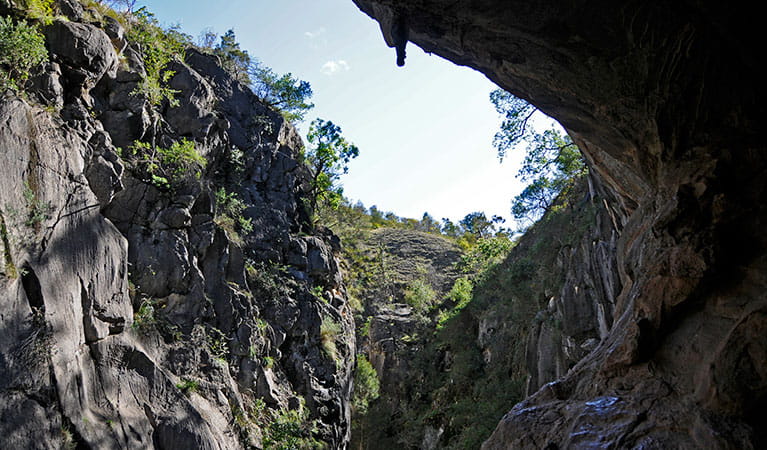
Wombeyan Karst Conservation Reserve is located within the traditional lands of the Gundungurra People, with the word Wombeyan coming from local language meaning 'Wombat' or 'home of the Wombat'. It's believed that Wombeyan Caves were part of an Aboriginal travel route, with the caves providing reliable shelter. The Dreamtime story of Gurangatch relates to the forming of Wombeyan and Jenolan caves. They are said to have been formed during a contest between 2 mythical beings, Gurangatch and Mirragang. Gurangatch was part fish and part reptile, and Mirragan was a legendary tiger cat.
Life in the air
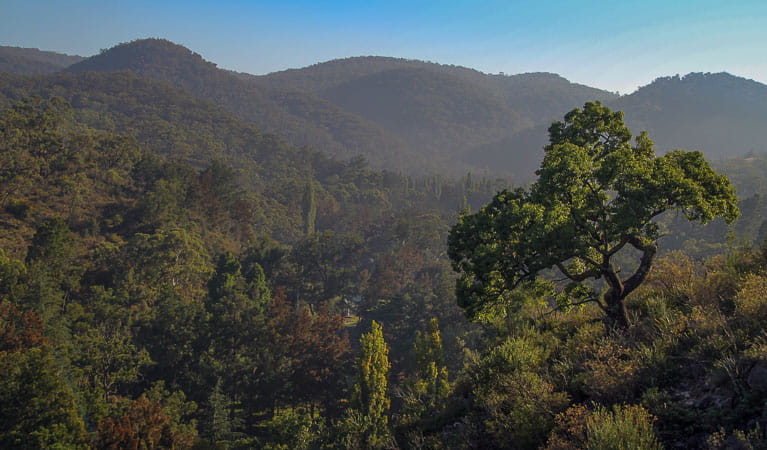
Wombeyan Karst Conservation Reserve plays a special role in the conservation of some of Australia's precious native flora and fauna. The moist forest that surrounds the park's creeks is home to superb lyrebirds, eastern whipbirds and flycatchers – look for lyrebird scratches on the forest floor. Around the park's rocky outcrops, see if you can spy birds of prey, including brown goshawks and wedge tailed eagles. You'll have to look particularly carefully to see a tawny frogmouth. Their camouflage is excellent – they stay very still and upright, and you might mistake them as part of the branch they're perched on.
- Victoria Arch walking track Victoria Arch walking track is a short, accessible walk in Wombeyan Karst Conservation Reserve. The easy bushwalk takes you to a viewing platform overlooking a remarkable natural rock formation.
On show
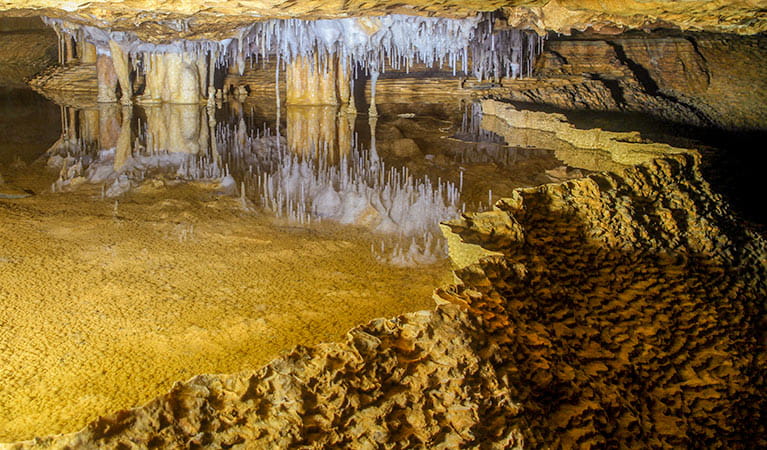
The limestone in the caves of Wombeyan Karst Conservation Reserve is 430 million years old. The geological processes that have created the magnificent cave system you see today continue to work their magic. You'll notice the impressive cave decorations, including stalactites and stalagmites, that are created by the infiltration of water into the caves. Take a guided cave tour to find out more about the history and geology of the caves.
- Dennings Labyrinth Dennings Labyrinth in Wombeyan Karst Conservation Reserve is currently closed to the public. Visitors will be advised when the cave reopens for tours.
- Fig Tree Cave Be sure to take a family-friendly, self-guided tour through the impressive Fig Tree Cave while you’re at Wombeyan Karst Conservation Reserve. It’s widely regarded as one of NSW’s best self-guided cave experiences.
- Kooringa Cave The ornately decorated Kooringa Cave in Wombeyan Karst Conservation Reserve is sure to impress. Bring your camera to capture striking columns and rippled draperies on a guided tour through this single-chamber cave.
- Mulwaree Cave Join a 1hr guided tour through the magnificent Mulwaree Cave in Wombeyan Karst Conservation Reserve. Inside this cave you’ll see shining decorations, large stalactites and spectacular colour variations on the walls.
- Victoria Arch walking track Victoria Arch walking track is a short, accessible walk in Wombeyan Karst Conservation Reserve. The easy bushwalk takes you to a viewing platform overlooking a remarkable natural rock formation.
Plants and animals protected in this park
Animals
-
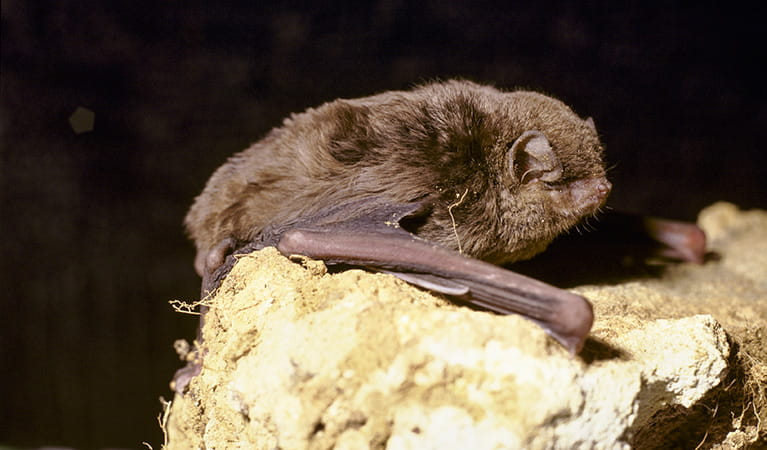
Eastern bentwing-bat (Miniopterus schreibersii oceanensis)
Eastern bentwing-bats congregate in caves across the east and north-west coasts of Australia, in colonies of up to 150,000. These small Australian animals weigh around 13-17g and can reach speeds of up to 50km per hour. Eastern bentwing-bats use both sight and echolocation to catch small insects mid-air.
-

Bare-nosed wombat (Vombatus ursinus)
A large, squat marsupial, the Australian bare-nosed wombat is a burrowing mammal found in coastal forests and mountain ranges across NSW and Victoria. The only other remaining species of wombat in NSW, the endangered southern hairy-nosed wombat, was considered extinct until relatively recently.
-
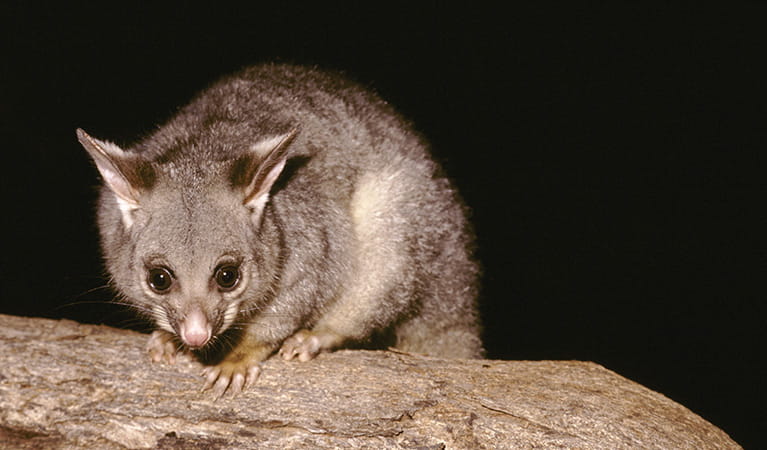
Common brushtail possum (Trichosurus vulpecula)
One of the most widespread of Australian tree-dwelling marsupials, the common brushtail possum is found across most of NSW in woodlands, rainforests and urban areas. With strong claws, a prehensile tail and opposable digits, these native Australian animals are well-adapted for life amongst the trees.
-

Common ringtail possum (Pseudocheirus peregrinus)
Commonly found in forests, woodlands and leafy gardens across eastern NSW, the Australian ringtail possum is a tree-dwelling marsupial. With a powerful tail perfectly adapted to grasp objects, it forages in trees for eucalypt leaves, flowers and fruit.
Environments in this park
Education resources (1)
Bookings
- National Parks Contact Centre
- 7am to 7pm daily
- 1300 072 757 (13000 PARKS) for the cost of a local call within Australia excluding mobiles
- parks.info@environment.nsw.gov.au
Park info
- in Wombeyan Karst Conservation Reserve in the Country NSW region
Wombeyan Karst Conservation Reserve is always open but may have to close at times due to poor weather or fire danger.

